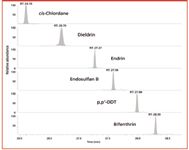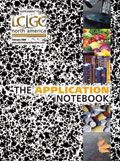Analyzing Pesticides in Rice Using GC–MS-MS and QuEChERS Sample Preparation
The Application Notebook
Thermo
Confirmation and quantification of pesticide residues in rice can be accomplished with low detection limits and high productivity by using gas chromatography and MSn coupled to a simplified sample preparation process.
The analysis of pesticide residues in rice crops is important for ensuring consumer safety, but this testing is complicated by the matrix, the nature of the pesticide residues, and the low detection limits and maximum residue limits (MRLS) set by various regulatory and governmental agencies. To successfully identify and quantify these compounds in rice, sample preparation and instrument parameters must be optimized. For this study, linear ranges, quantitation limits, and detection limits for 32 pesticides commonly used on rice crops were determined using gas chromatography and tandem mass spectrometry on the Thermo Scientific ITQ 700 GC–MS system.

Figure 1: Extracted product ion profiles for selected pesticides in rice at 160 ng/g, demonstrating the enhanced selectivity of MS-MS
Experimental Conditions
Sample Preparation
All studies were performed using extracted rice matrix, including the calibration curve. Rice was homogenized with water, taking care to note water volume usage. A modified QuEChERS sample preparation was used (1, 2). Exothermic reactions with the extraction reagents were minimized to improve recoveries. Sample extraction was followed by a solvent exchange step. This solvent exchange removed the acetonitrile in favor of a 9:1 hexane:acetone solution, a solvent that is more amenable to gas chromatography. This step further improved recoveries and overall chromatographic performance.
GC–MS-MS Analysis
The ITQ 700™ GC–MS system was operated in MS-MS mode for all standards. Product ions were selected that would provide diagnostic product ion spectra that can be used for identification. MS-MS analysis on the ITQ 700 improves selectivity and allows for lower detection limits by reducing the matrix background around the target ions. Figure 1 shows the extracted product ion profiles for six selected pesticides spiked in rice at 160 ng/g. The method was fully tested, including linearity, method detection limits, and precision.
Results
Linearity was determined using calibration curves spiked into rice matrix. Levels ranged from 1 ng/g to 1200 ng/g, depending on the compound and its MRL in rice. The linearity for all compounds was R2 > 0.995, with an average R2 of 0.9993 across 32 pesticides. Limits of detection (LOD) and quantitation (LOQ) were determined by preparing matrix spikes at levels near or below the MRLs. Concentrations of 16, 32, 40, 80, and 120 ng/g were analyzed in seven matrix samples, and the LOD and LOQ were calculated from these results by multiplying the standard deviation of the calculated amounts by 3 and 10 respectively. The average LOD across the 32 pesticides was 9 ng/g and the average LOQ was 29 ng/g. Method precision was demonstrated by analyzing five matrix samples spiked at 160, 320, and 480 ng/g. Samples had average recoveries of 98%, and an average % relative standard deviation (RSD) of 5.9%.
Conclusions
The Thermo Scientific ITQ 700 can be used to analyze and quantify pesticide residues in rice with excellent precision, low detection limits, and with the added confidence of MS-MS. The detection limits easily met or exceeded published limits, and high recoveries and excellent precision create a robust and reliable method that can be used to productively test for pesticides in rice.
References
1) Lehotay, S. AOAC Official Method 2007.01 Pesticide Residues in Foods by Acetonitrile Extraction and Partitioning with Magnesium Sulfate. Journal of AOAC International. Vol. 90, No. 2, (2007) 485–520.
2) Steiniger, D., Butler, J., and Phillips, E. Multi-residue Pesticide Analysis in Rice by a Modified QuEChERS Extraction and Ion Trap GC/MSn Analysis. Thermo Scientific Technical Note #TN10239. www.thermo.com.

Thermo Fisher Scientific, Inc.
355 River Oaks Parkway, San Jose, CA 95134-1991
tel. (800)532-4752, fax (561)688-8731
Website: www.thermo.com
















